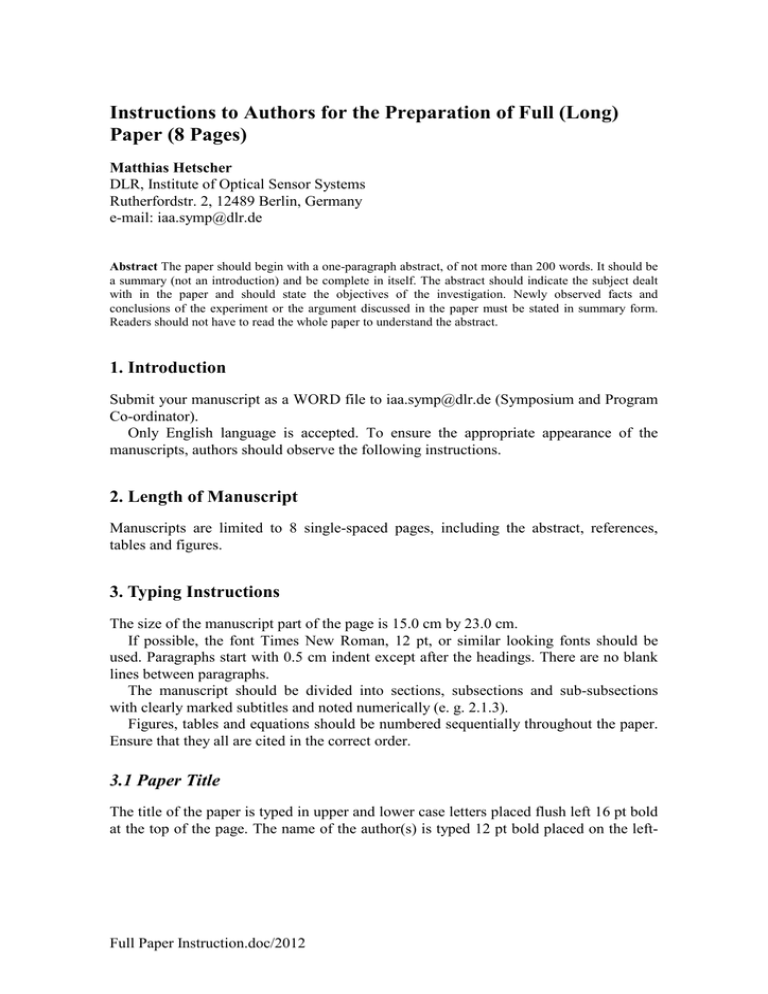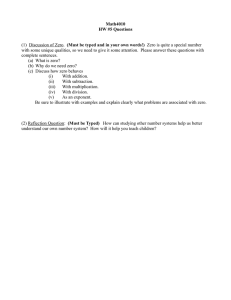Full Paper Instruction
advertisement

Instructions to Authors for the Preparation of Full (Long) Paper (8 Pages) Matthias Hetscher DLR, Institute of Optical Sensor Systems Rutherfordstr. 2, 12489 Berlin, Germany e-mail: iaa.symp@dlr.de Abstract The paper should begin with a one-paragraph abstract, of not more than 200 words. It should be a summary (not an introduction) and be complete in itself. The abstract should indicate the subject dealt with in the paper and should state the objectives of the investigation. Newly observed facts and conclusions of the experiment or the argument discussed in the paper must be stated in summary form. Readers should not have to read the whole paper to understand the abstract. 1. Introduction Submit your manuscript as a WORD file to iaa.symp@dlr.de (Symposium and Program Co-ordinator). Only English language is accepted. To ensure the appropriate appearance of the manuscripts, authors should observe the following instructions. 2. Length of Manuscript Manuscripts are limited to 8 single-spaced pages, including the abstract, references, tables and figures. 3. Typing Instructions The size of the manuscript part of the page is 15.0 cm by 23.0 cm. If possible, the font Times New Roman, 12 pt, or similar looking fonts should be used. Paragraphs start with 0.5 cm indent except after the headings. There are no blank lines between paragraphs. The manuscript should be divided into sections, subsections and sub-subsections with clearly marked subtitles and noted numerically (e. g. 2.1.3). Figures, tables and equations should be numbered sequentially throughout the paper. Ensure that they all are cited in the correct order. 3.1 Paper Title The title of the paper is typed in upper and lower case letters placed flush left 16 pt bold at the top of the page. The name of the author(s) is typed 12 pt bold placed on the left- Full Paper Instruction.doc/2012 hand margin of the page in upper and lower case letters. Affiliation(s) and complete address(es) are typed 12 pt placed flush left in upper and lower case letters. 3.2 Headings Headings of the sections are typed 14 pt bold placed flush left in upper and lower case letters. Subheadings and Sub-subheadings are typed 14 pt in bold italic upper and lower case letters placed flush left. 3.3 Footnotes Footnotes, if absolutely necessary, should be marked in the text with (a)*, asterisk; (b)**, double asterisk. Footnotes are typed 10 pt. 3.4 Illustrations and Captions Keep in mind that all artwork, captions, figures, graphs and tables will be reproduced as you submit them. Therefore, make sure to paste into position all your work exactly as you want it to appear in the final paper. 3.5 Symbols and Abbreviations Use only standard symbols and abbreviations in text and illustration. 3.6 Mathematics The numbers identifying equations should be placed in parentheses on the right. Make sure that no ambiguities arise. 4. Page Numbers No page numbering is necessary. 5. Keyword Indicate, please, three to five keywords to be included in the index. Full Paper Instruction.doc/2012 References Make sure citations in the text (in square brackets) agree with the reference list and any listed reference is cited in the text. Group the references at the end of the paper in numerical order, typed 10 pt and presented as follows: [1] J. K. Knowles and E. Reissner, Note on stress-strain relations for thin, elastic shells. J. Math. Phys. 37, 269-282 (1958) [2] H. S. Carslaw and J. C. Jaeger, Operational Methods in Applied Mathematics, 2nd edn. p. 121. Oxford University Press, London (1953) Full Paper Instruction.doc/2012

